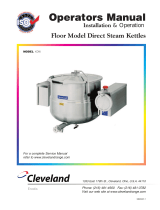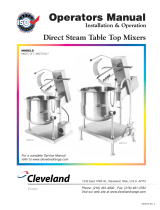
Stainless Steel Care & Cleaning
2
Stainless Steel Care & Cleaning
General
Stainless steel is a “passive” metal because it contains other
metals like chromium, nickel and manganese that stabilize the
atoms. Chromium provides an invisible passive lm that covers
the steel surface, acting as a shield against corrosion. As long
as the lm is intact and not contaminated, the metal is passive
and stainless. If the passive lm of stainless steel has been
broken, equipment can start to corrode and rust.
Three materials or processes can break down stainless steel’s
passive layer and allow corrosion to occur:
• Mechanical abrasion
• Deposits and water
• Chlorides
Mechanical abrasion refers to items that will scratch a steel
surface. Steel pads, wire brushes and scrapers are prime
examples.
Water comes out of the faucet in varying degrees of hardness.
Hard water may leave spots. When allowed to sit, these
deposits will break down the passive chromium layer and rust
stainless steel. Other deposits from food preparation must be
promptly removed with an appropriate cleaning agent.
Chlorides are found nearly everywhere. They are in water, food
and table salt. Household and industrial cleaners are the worst
oenders.
Preventing Stainless Steel Rust
Use non-abrasive tools to clean stainless steel products. Soft
cloths and plastic scouring pads will not harm the steel’s
passive layer.
Clean with polish lines. Some stainless steels have visible
polishing lines or “grain”. When visible lines are present, always
scrub in a motion parallel to the lines. When the grain cannot
be seen, polish in a consistent straight pattern and not in a
circular motion.
Use alkaline, alkaline chlorinated or non-chloride containing
cleaners. While many traditional cleaners are loaded with
chlorides, the industry is providing an ever-increasing choice
of non-chloride cleaners. If you are not sure of chloride content
in the cleaner being used, contact your cleaner supplier. If your
present cleaner contains chlorides, ask your supplier for an
alternative. Avoid cleaners containing quaternary salt; it also
can attack stainless steel and cause pitting and rusting.
Keep food equipment clean. Use alkaline, alkaline chlorinated
or non-chloride cleaners at recommended strength. Clean
frequently to avoid build-up of hard, stubborn stains. The
single most likely cause of damage is chlorides in the water.
Remember, adding heat to cleaners that contain chlorides
dramatically increases their eect on stainless steel.
If chlorinated cleaners are used, immediately rinse and wipe
equipment and supplies dry. The sooner you wipe standing
water, especially when it contains cleaning agents, the better.
After wiping equipment down, allow it to air dry. Oxygen
helps maintain the stainless steel passive lm.
NEVER use hydrochloric acid (muriatic acid) on stainless
steel. Do not use abrasive cleansers or cloths on any inte-
rior or exterior surfaces or removeable parts.
Cleaning Non-Metallic Surfaces
Glass panels may be cleaned using any standard glass
cleaner available on the market.
To clean interior and exterior non-metallic surfaces and
removable parts, wash with mild solution of soap and
lukewarm water with a little baking soda. Rinse and dry
thoroughly. Avoid getting water on the lights, controllers, fan
motors and unnished wood wine rack faces.
Cleaning the Refrigeration System Condenser
The condenser (located behind the front grille cover) should
be cleaned every three (3) months. Use a soft bristle brush
and vacuum to remove dust and lint.
Avoid damaging or crushing the condenser ns or tubing.









